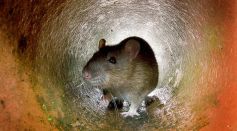Tags: Gene editing
In Vivo Gene Editing: Scientists Use CRISPR Technology to Modify DNA Inside a Person’s Body
CRISPR Pigs Immune to Blue-Ear Disease Could Be the First Widely Consumed Gene-Edited Animals
Is CRISPR Treatment Approved For Human Use? What Is It Mostly Used For?
Search Algorithm Reveals 188 New Kinds of CRISPR Systems; Rich Diversity Expands Possibilities for Precise Gene Editing
CRISPR Gene Editing Makes Chickens Resistant to Bird Flu, Offers Breakthrough in Animal Immunity Against Infection

Gene Editing on Chickens Done To Identify, Alter DNA Parts To Hamper Bird Flu Spread
Chinese Scientist Gets Back in the Gene Editing Industry After Being Convicted From His Past Experiment

Creating Horn-Free Cows Using Gene Editing: Is It Acceptable Under Federal Regulation?

Gene Editing Startup Pairwise Introduces Food Made With CRISPR Technology Making Vegetables More Palatable

Novel Nanoparticles Can Deliver mRNA in the Lungs to Aid in Gene-editing With a Potential of Developing Treatment for Cystic Fibrosis, Other Lung Diseases
De-extinction: Gene Editing Technology Might Help Bring Back Extinct Species to Life

New Gene Editing Therapy May Help Treat Cardiovascular Disease, Repair Damaged Tissue After Heart Attack

First Man-Made Living Mammals Created by Recombining Chromosomes of Living Mouse

Scotland Opposed UK Bill Over Genetically-Edited Food Produce from Animals, Plants With Altered DNA

Monster Hamsters Accidentally Created Turning Mice Models Into Rodents That Chase, Bite, Pin Down Each Other

Unexpected Changes of Social Behaviors in Mammals Discovered with CRISPR-Cas9 Gene Editing

Scientists Plan to Resurrect Extinct Christmas Island Rat; But Could De-Extinct Technology Save Endangered Animals?

Scientists to Resurrect the Lost Species of Tasmanian Tiger, Extinct Marsupials Will Bring Balance Back in Tasmania's Ecosystem

Genome Editing for Microbiomes Available Soon Through New CRISPR Development
Lizards Regenerate Perfect New Tails With Bone and Nerves After Being Injected With Gene-Edited Stem Cells
Most Popular

Largest Known Volcanic Aquifer Discovered Beneath Oregon's Cascades

New 'Supergiant' Sea Bug Found in South China Sea, Named After Darth Vader

Mediterranean Sea Was Refilled by a Catastrophic Flood Millions of Years Ago

Mysterious Cosmic Waves That Sound Like Birds Detected in Unexpected Space Region





